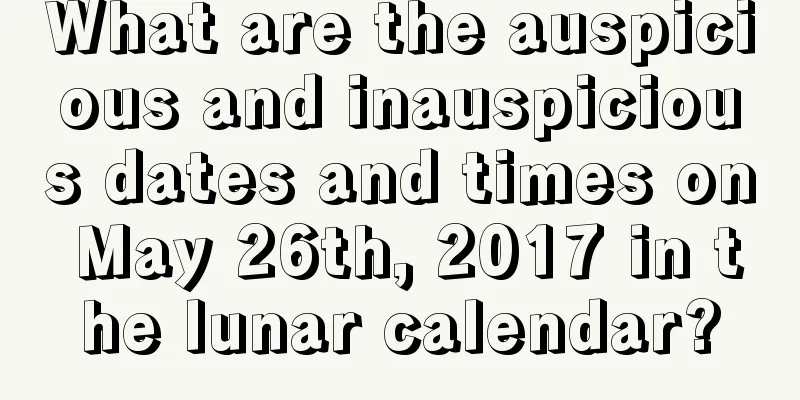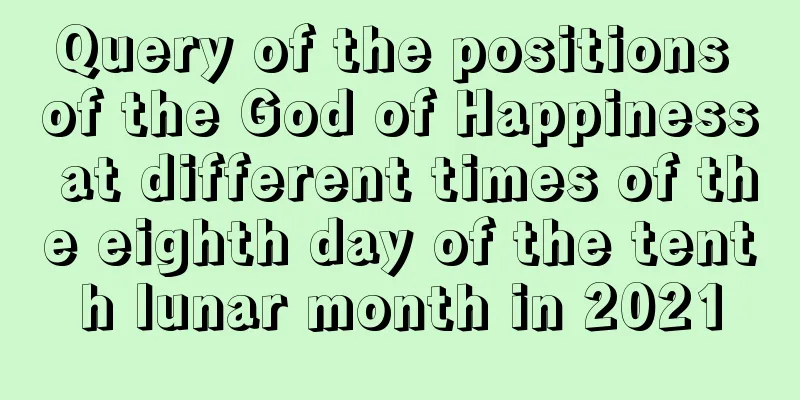The origin of the compass and what are the uses of the compass?

Introduction: With today's rapidly developing era, the use of traditional compasses has gradually been replaced by electronic compasses, which are more precise and less susceptible to interference. So what is the origin of the traditional compass? What are the application values? Let’s follow the editor to learn more about it below! If you want to know more articles and content related to the compass, please quickly enter the other compass-related article topics that Mr. Shui Mo has carefully prepared for you. Everything you want to know is there!The Origin of the CompassCompass, also known as Luojing, is an essential tool for Feng Shui operations. It has gone through a long historical process from its invention to its gradual perfection. According to the preface to "A Complete Explanation of the Compass" written by Wang Daoheng of the Qing Dynasty, "The Yueji Compass was first created by Emperor Xuan, and was followed by Duke Zhou to determine the directions of the compass. However, there were only twelve gods in the prenatal world, and Zhang of the Han Dynasty paired them with eight heavenly stems and four dimensions, and placed them inside, which was called the ground plate. Mr. Yang and Mr. Lai added two more layers, one inside and one outside, called the sky plate, which combined into three elements." From this we can see that as early as the Tang and Song Dynasties, the three main compass needles (main needle, center needle, and seam needle) had been basically established. After the Northern Song Dynasty, as Feng Shui theory became more and more perfect, Feng Shui became popular in China. At this time, some feudal scholars also joined in, and wrote books and articles, and then added layers of the compass in an innovative way. By the late Qing Dynasty, the Feng Shui compass had formed into a device with more than forty layers, which was all-encompassing and could measure the destiny of the stars and the cycle of reincarnation, distinguish the auspiciousness and inauspiciousness of the directions of mountains and rivers, and determine the disasters and blessings of the world. It was the most precious Feng Shui compass that could be used in everything.Yang Yunsong, whose courtesy name was Shumao and nickname was Jiupin. He was from Douzhou. He was born in the eighth year of Taihe reign of Emperor Wenzong of Tang Dynasty (834 AD) and died in the third year of Tianyou reign of Tang Dynasty (906 AD) at the age of 73. Buried in Duyaokou (now Yudu, Jiangxi). Yang had three brothers: the eldest, Yunyi, the second, Yunbin, and Song was the third. He learned poetry and calligraphy since childhood, and passed the imperial examination at the age of seventeen. He was later transferred to Chang'an, the capital of the Tang Dynasty, to serve. During the reign of Emperor Xizong (874-889 AD), he was appointed as the national teacher and promoted to the rank of Jinzi Guanglu Dafu, a third-rank official, in charge of Lingtai geographical affairs. In 880 AD, Huang Chao's rebel army captured Chang'an. Yang and his friend Zewei, a servant of the Imperial Astronomical Bureau, took the palace's geomancy secrets with them to Qianzhou (now Ganzhou, Jiangxi) to avoid the war. They were attracted by the local feng shui and settled down there, devoting themselves to studying feng shui. He also left behind such masterpieces as "Qingxiang Ao Yu", "Hanlong Jing" and "Yilong Jing". It is not difficult to see from his works that Yang Yunsong, on the basis of inheriting the Feng Shui theories of his predecessors, through dedicated research and repeated practice, not only created a complete Feng Shui theoretical system and operating methods that took into account the suitability of the local conditions, selected the shapes, searched for dragons, pointed out the acupoints, observed the water, inspected the sand, and set the direction, but also had unique insights into the improvement and application of the compass, and its reasonable components are clearly verifiable. 1. Setting of Yin Yang DragonThere are two types of compasses: Yang pan and Jiang pan. The arrangement of the levels has never been fixed. Some compasses have the Yin-Yang Dragon on the seventh layer, while others have the Yin-Yang Dragon on the eleventh layer. Most compasses after the Qing Dynasty directly use red and black colors to mark the yin and yang dragons on the twenty-four mountain needles (i.e. the ground). The ancient compass before the end of the Tang Dynasty only had twenty-four mountains in the direction of the magnetic pole and the number of hexagram examples. Dragon examination, direction setting, sand elimination and water intake were all completed within the twenty-four mountains. Although when did the Yin-Yang Dragon setting begin? Who is it from? There is no record in ancient books, but from the ancestral tombs that Yang Yunsong personally selected for the Ningdu Lu and He families, and the Yudu Zhang families (which still exist), as well as the words in the "Qingxiang Ao Yu Xu" dictated by Yang Yunsong to Zeng Wentan, "Yang Gong looked at the male and female when raising his children, and the books in the world have different opinions," it can be inferred that the setting of the Yin-Yang dragon was no later than the end of the Tang Dynasty, and it is obvious that it was created by Yang Yunsong.In his Feng Shui practice, Yang Yunsong applied the principle of the innate Bagua in view of the complexity and diversity of dragon-seeking and acupoint selection in mountainous and hilly areas, as well as the yin and yang attributes between mountains and waters, namely, "Qian takes Jia, Kun takes Yi, Ren, Yin, Shu and Li Palaces take Li, Kan, Gui, Shen and Chen take water, which combines the four Yang hexagrams; Gen takes Bing, Xun takes Xin, Zhen and Dong take Geng at the end of Hai, You and Dui take Ding, Yi and Chou gold, which combines the four Yin hexagrams." The principle. It was deduced that the twelve yang dragons and twelve yin dragons were first divided among the twenty-four mountain needles. According to Yang Yunsong's unique view that mountains are yin, water is yang, stillness is yin, movement is yang, left rotation is yang, right rotation is yin, and solitary yin cannot produce, solitary yang cannot grow, and when yin and yang interact, all things come into being. When a cave is formed on a yang mountain, no matter it is a downstream situation, a horizontal situation, or an upstream situation, water generally flows from right to left; when a cave is formed on a yin mountain, water generally flows from left to right. That is to say, for yangshan, the natural water outlet is on the left side of the tomb, and for yinshan, the natural water outlet is on the right side of the tomb. There is no exception across the country. Of course, the prerequisite principle is that there is a dragon cave in the mountain. The second is to follow the dragon’s direction and point the acupoints. The third is to determine the direction based on water. For example, if the mountain is Gan and the direction is Xun, Gan is a Yang mountain, so the water will definitely flow from right to left; if the mountain is Wei and the direction is Chou, Wei is a Yin mountain, so the water will definitely flow from left to right. Why? Yin mountains are paired with yang water, and yang mountains are paired with yin water. The union of yin and yang is a perfect match for husband and wife. This is the natural law of the creation of heaven and earth, and the terrain of mountains and rivers. It is reflected on the compass as the Yin-Yang Dragon. Therefore, the setting of the Yin-Yang Dragon not only reflects the objective laws of the terrain, but also profoundly reveals the philosophical idea of the balance of Yin and Yang and the harmony of Nine-Six in nature. It allows the operator to know the direction of the mountain range, its origins and development, the incoming and outgoing water, and the presence or absence of caves just by putting out the mountaineering compass when working in mountainous or hilly areas. From this we can see that Yang Yunsong set up the Yin-Yang Dragon with the intention of making it easier for practitioners to find dragons, observe water, and point acupoints. Therefore, it is said in Qingxiang Aoyu, "If someone knows Yin and Yang, why worry about not meeting each other on earth?" As for the method of purifying yin and yang that has been popular since the Song Dynasty, there is the theory of setting up a yang direction for a yang mountain and a yin direction for a yin mountain, as well as the theory of Yin mountain being more noble than Yang mountain*. The author believes that it goes against Yang Gong’s original intention of setting up the Yin-Yang Dragon, is untenable in legal theory, and is even more unworkable in practice. 2. Needle SettingThe sewing needle, also known as the sky plate, has different numbers of layers due to different compass models. The sewing needle takes the north and south indicated by the compass of Tianchi as the reference. The north-south position of the main needle is in the boundary seam of Ren Zi Bing Wu of the sewing needle, while the north-south position of the sewing needle is in the boundary seam of Zi Gui and Wu Ding of the main needle, hence the name. Based on the 360 degrees of the celestial sphere, the sub-position of the straight needle is at 0 degrees, and the sub-position of the sewing needle is at 7.5 degrees. The sewing needle indicates the direction of the daylight, that is, the direction of sunlight. The "Imperially Approved Interpretation of the Compass" written by Hu Guozhen in the Qing Dynasty directly calls Yang Gong's Sewing Needle's Twenty-Four Dragons the name Sewing Needle. The ancients named the sewing needle "Yang Gong Sewing Needle", which shows that the sewing needle was invented by Yang Yunsong, which is beyond doubt.The purpose of the sewing needle is to hold water. The purpose of Feng Shui is to allow the tomb to absorb vital energy inside and connect to the hall energy outside. In his Feng Shui practice, Yang Yunsong realized the importance of the effects of earth energy and weather on tombs and houses. Therefore, based on the principles of the twelve palaces of birth, prosperity and tomb in numerology, he created the Double Mountain Sewing Needle in the daytime direction, which was specifically used to collect water. The sewing needle is the same as the regular needle, which is the twenty-four mountains. It is based on the twelve branches and supplemented by the eight stems and four dimensions. That is, Ren assists Zi, Gui assists Chou, Gen assists Yin, Jia assists Mao, Yi assists Chen, Xun assists Yi, Bing assists Wu, Ding assists Wei, Kun assists Shen, Geng assists You, Xin assists Shu, Gan assists Hai, so Ren Zi is in the same palace, Gui Chou is in the same palace, Gen Yin is in the same palace... The reason why the sewing needle is called Shuangshan is because of this. Use the double mountain sewing needle to distinguish the directions of dormancy, imprisonment, prosperity and growth, and eliminate the incoming water. It is developed according to the birth, prosperity and burial of the four bureaus of gold, wood, water and fire. For example, in the Yi, You, and Chou three-combination metal bureau, the place of birth is Si, the place of prosperity is You, and the place of burial is Chou. There are also the water combination of Shen, Zi and Chen, the fire combination of Yin, Wu and Shu, and the wood combination of Hai, Mao and Wei. It is reflected in the sewing needles, that is, Xun and Yi are in the same palace, Geng and You are in the same palace, and Guichou are in the same palace. Therefore, Yang Yunsong said at the beginning of "Qingxiang Ao Yu": "Kun, Ren, and Yi are Wenqu from the beginning, Gen, Bing, and Xin are all Lianzhen, Xun, Geng, and Gui are all Wuqu, and Gan, Jia, Ding, and Tanlang are all along the way." Among them, Wenqu refers to the water bureau named after the nine stars, Lianzhen refers to the fire bureau, Wuqu refers to the metal bureau, and Tanlang refers to the wood bureau. In the application of sewing needles, one should first observe the water outlet, that is, determine the water outlet around the tomb and house. If the water outlet is in the Guichou direction, you will know that it is the tomb of the Gold Bureau. Then, when setting the direction, you should set the Gold Bureau direction to collect the prosperous water into the hall and release the imprisoned water to get rid of the evil. For example, when Yang Yunsong buried the mother of Lu Guangchou, the governor of Qianzhou in the late Tang Dynasty, he set up the Xinshan Yixiang, collecting the fresh water from the left Genyin and the prosperous water from the right Bingwu, which merged into the Jiamao direction. This is a clear proof. However, it should be emphasized that this only refers to the method of collecting water for mountain orientation, which is often referred to as the method of longevity water. As for the flat land and lake land, Yang Yunsong applied corresponding water methods according to the suitability of the local conditions. Since the Tang and Song Dynasties, the reason why various Feng Shui schools have held different opinions and argued endlessly, all claiming to have received the true teachings of Yang Gong, is that in fact most of them only have a superficial understanding. The reason is that people only know one side of Yang Gong's water method, but not the other. As a result, the Feng Shui industry was in turmoil and the public response was mixed. 3. Setting of the Seventy-two DragonsThe Seventy-two Dragons are also known as the Seventy-two Mountain-Drilling Dragons. "Jie Ding" said: "Seventy-two points of gold, also known as seventy-two dragons. There are sixty in Jiazi, plus the eight stems and four dimensions, it becomes seventy-two positions, distributed in twenty-four mountains, one mountain governs three dragons, to correspond to the seventy-two years and months (gold edge and jade box), called Di Ji, which is specially used for setting up caves and directions. Various interpretations say that it is about the origin of veins from mountains, but it is wrong." The seventy-two dragons are set under the main needle, with the sixty Jiazi Na Yin, plus the twelve empty dragons in the middle of the eight stems and four dimensions, called the seventy-two dragons. Yang Yunsong took into account that the orientation of mountains is different from that of plains. He used the principle of the calendar that there are 24 solar terms every year, and each solar term is divided into upper, middle and lower phases, making a total of 72 climates. He placed them in the 24 mountain needles in order to achieve the state of unity of man and nature, unity of time and space, making it possible for the tomb to take advantage of the vitality inside the tomb and connect to the hall energy outside, and to communicate with the mysterious orifices.The setting of the seventy-two dragons and the sewing needles are the inside and outside of each other and interact with each other. Therefore, it was natural for Yang Yunsong to add seventy-two dragons while setting up the sewing needles. For example, if you examine a certain cave site on Gui Mountain, and use the Tianpan Xizhen grid to find that the Yuanchen water mouth is in the Dingwei direction, you will know that it is the water mouth of the Haimaowei Wood Bureau. The 72 dragons attached to Gui Mountain are Ren Zi, and the dragon's Na Yin is wood. Set up Gui Mountain Ding Xiang and Ziwu to receive the Linguan, Diwang and Jumen water on the left and the Yangsheng water on the right, and it will be legal when it comes out of the tomb mouth Dingwei direction. "Luo Jing Tou Jie" stated: "In the past, people used 72 dragons to drill through mountains. Those who drilled through mountains determined which Jiazi the dragon belonged to. It was called Di Ji, which focused on discussing the dragon." The author believes that the 72 dragons are mainly based on the weather and are used to determine the direction. The number of dragons should be sixty. Because the middle needle indicates the direction of the moon's shadow and reflects the relationship between the earth and the moon (discussed in another article), its function is to eliminate sand. According to the theory of Yin and Yang and the Five Elements, dragon and sand are both Yin and have the same nature. The difference lies in the primary and secondary relationships between dragon and sand in the Feng Shui layout. The mountain range where the acupuncture point is located is called dragon, and the mountains surrounding the acupuncture point are called sand. Sixty dragons are set under the center needle, and sixty dragons should be used to determine the dragon. Using seventy-two dragons to align with each other is neither in accordance with the laws of nature nor with geography, and even less reasonable. This can be evidenced by the Tang Dynasty ancestral tomb of revolutionary pioneer Sun Yat-sen, Sun Wei, in Ningdu, Jiangxi Province. The tomb is built on the Zi mountain and faces the Wu direction, with both Ren and Bing directions. The water flows from the right to the left. After the burial, many of his descendants passed the imperial examinations and became officials. Feng Shui is a practical science. It is difficult to understand its mysteries without reading thousands of books and traveling thousands of miles. After Yang Pan's main needle, sewing needle, seventy-two dragons and yin-yang dragons were established, Lai Wenjun (a native of Ningdu, Jiangxi Province) of the Southern Song Dynasty introduced the center needle of the moon's shadow into the compass. At this point, the three main needle plates of the compass are all ready, for examining dragons, determining directions, eliminating sand, and collecting water, each performing its own function and complementing each other. Summary: The above is an analysis of the origin and application of the compass. Friends who are interested in the compass can refer to it! I hope this article is helpful to you! |
<<: Detailed explanation of the principles and usage of Feng Shui compass!
>>: What Feng Shui considerations do you need to know when placing a Feng Shui compass at home?
Recommend
Is Qingming Festival based on the Gregorian calendar or the lunar calendar? What are the activities for Qingming Festival?
Qingming Festival is also one of the traditional f...
Can I get married around the Ghost Festival in 2019? Recommended auspicious dates for marriage around the Ghost Festival in 2019!
Introduction: Getting married is an important matt...
What can’t you do during the Lantern Festival in 2022? What are the taboos during the Lantern Festival?
The Lantern Festival, also known as the Shangyuan ...
Is the first day of the fifth lunar month in 2017 a suitable time to move into new house? Happy housewarming day!
Moving into a new house is a great event in life, ...
What should we bite on the beginning of spring? Why does the Beginning of Spring start with the word “Spring”?
The Beginning of Spring is a festival among the tw...
Is it a good time to move into new house on the tenth day of the sixth lunar month in 2020? What will the day be like?
June is a hot month and the lotus flowers are in ...
Where can Virgo easily find his soulmate during the 2017 Lantern Festival?
Introduction: The Lantern Festival is not only an ...
Do people born in Guyu have good fortunes? What are their personalities and fortunes like?
People born during the Grain Rain period have extr...
Can I move on June 19th of the lunar calendar in 2018? Is it okay to move into a new house?
The sixth month of the lunar calendar is approach...
What day is July 22nd in the lunar calendar 2019? What are the signs of the day?
July is the beginning of the second half of the y...
What day is the tenth day of the first lunar month? How is life?
Introduction: The tenth day of the first lunar mon...
A complete collection of WeChat greetings for the Mid-Autumn Festival in 2020. Wouldn’t it be nice to move to a new house during the Mid-Autumn Festival in 2020?
Introduction: Different festivals have different b...
Is it auspicious to move into a new house on November 11, 2020 in the lunar calendar?
Is it auspicious to move into a new house on Nove...
Is it good for a girl to be born on the 16th day of the twelfth lunar month in 2018? What is the hexagram of the day?
The birth of every new life is always highly antic...
What is the date of November 30th in the lunar calendar in 2017? Is it a suitable day for sacrifices?
Introduction: In our country’s traditional culture...









